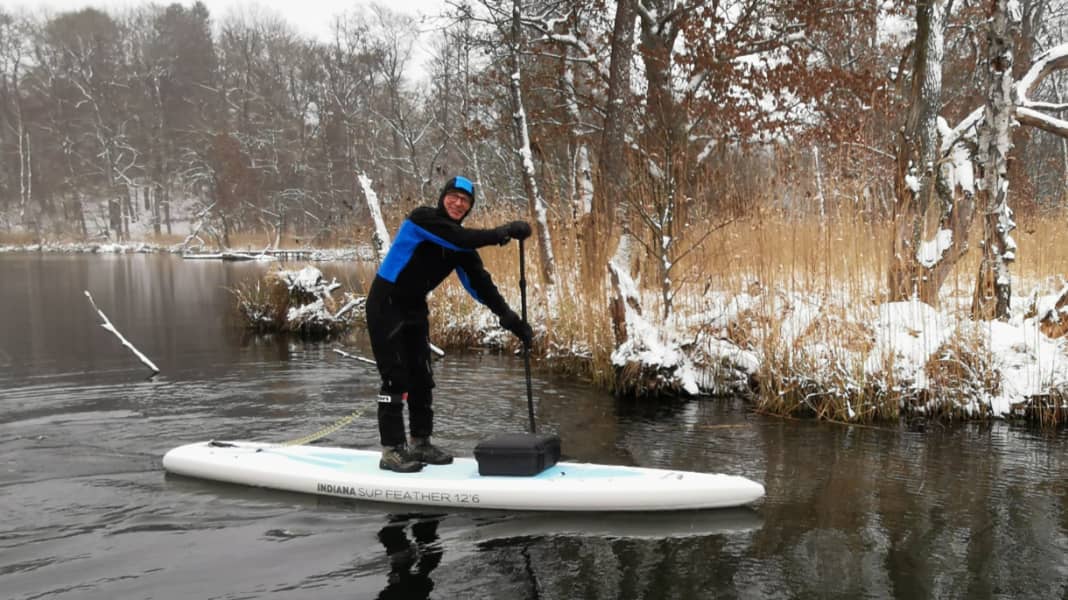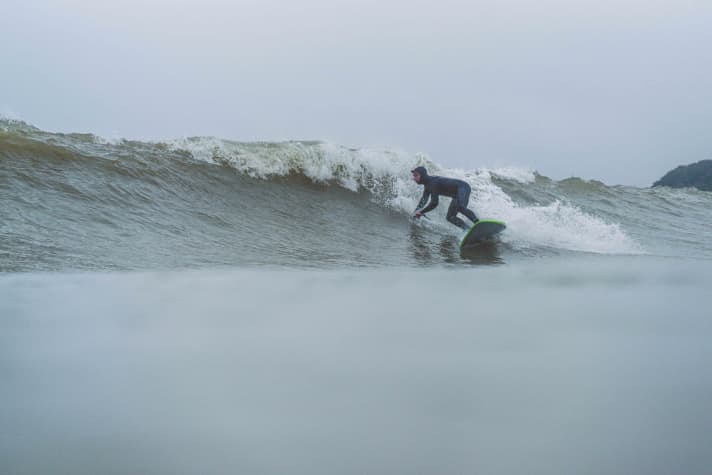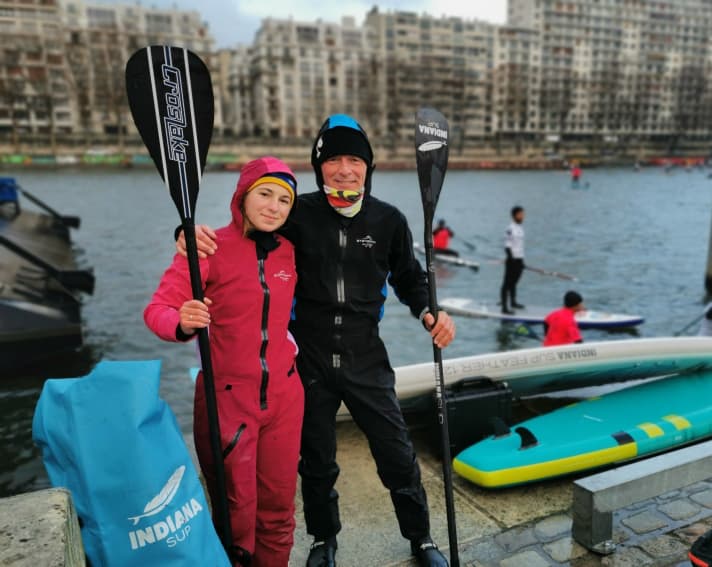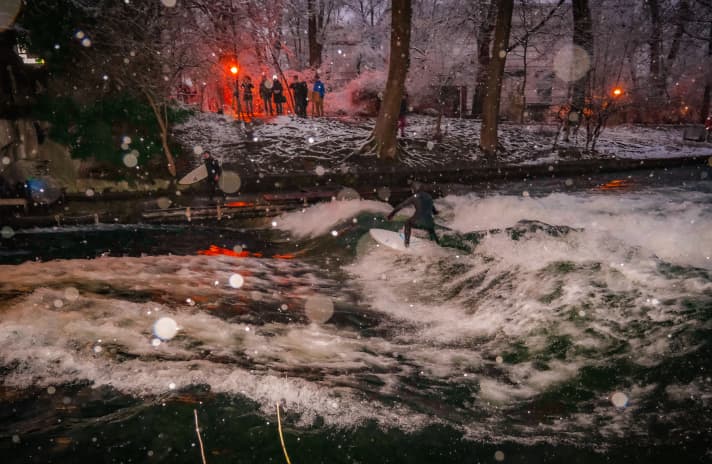SUP guide: Travelling by SUP in winter - everything you need to know about clothing and safety
Stephan Gölnitz
· 05.01.2024

Poor (or often no special) SUP clothing unfortunately limits the SUP season in northern Europe to a few months in summer, namely the temperatures when falling into the water and paddling on in shorts and lycra are no problem. For many sailors who have a SUP on board, this is not a problem. However, the board can be used well not only on trips in the warmer months, but also in winter on local waters. Stephan Gölnitz, SUP expert at our sister magazine SURF gives tips on paddling in the cold season.
A winter SUP tour often offers impressive experiences. However, it is clear that you should protect yourself very well in the cold. The days when the sun is deceptively warm in winter or spring are particularly treacherous, but a fall into the water can catch you out in the cold. After all, falling into six-degree water wearing only functional trousers and a fleece jumper is potentially life-threatening.
SUP safety in winter
No matter how well dressed you are, long swims should be ruled out. A leash is therefore almost more important than clothing, because your board is also your life raft - with the exception of white water rivers with obstacles. The safety basics for winter paddling:
- Wear a leash
- do not paddle alone
- Assess the weather (wind) in advance
- Plan an emergency exit from a tour
- No long water crossings
- Have your mobile phone with you
A dry suit is usually the first choice for SUP clothing in winter
Winter clothing is clearly the order of the day at the moment. A wetsuit or drysuit is the only suitable clothing for this. Wetsuits are often criticised as unsuitable for SUP, but this is not entirely true, as further down to read. Nevertheless, special SUP drysuits remain the first choice in most cases because they are much more comfortable on tours or for training. There are also a few things to bear in mind, which are explained further on in the article.

SUP drysuits
Drysuits for SUP can be divided into two types: very robust versions for white water and the more elastic, thinner ones for touring and training. These also offer a certain amount of breathability in certain conditions. The whitewater suits are usually sealed at the neck with an all-round cuff - which doesn't let water in even when washing, but is more uncomfortable to put on. A Interview with one of the leading manufacturers with lots of information about drysuits we have prepared here. A comfortable (wide enough or elasticated) drysuit with appropriate underwear is probably the best equipment for touring paddlers. However, there is one thing you should not underestimate: The drysuit only consists of a very thin laminate and does not insulate against the cold during longer swims. This can only be achieved with appropriate underwear. If it does get too warm in the winter sun in the "dry suit", as some people affectionately call it, it is tempting to leave the zip open - but this is a bit like putting a seatbelt around your neck in a car. You should visualise falling into the water with your drysuit wide open beforehand. A good SUP drysuit
- is waterproofed at the sleeves, legs and neck,
- offers freedom of movement to the front and for the arms,
- ideally has at least one waterproof pocket for the phone,
- naturally closes with a waterproof zip.
Underwear under the drysuit
The underwear, which can be anything from functional underwear to merino, regulates the warmth in the drysuit and can therefore be customised for temperatures from zero to 15 degrees. Ideally, the underwear should have a certain "fluffiness" and thus also form an insulating layer in the water. There is a wide range of options for this, for example in the ski sector. In our experience, thick long pants and a ski vest plus a medium-thick fleece jumper are suitable for temperatures between zero and ten degrees - although this always depends on whether the sun is peeking out. However, specialised providers also offer Good, if not quite cheap, underwear to.

Mandatory: warm shoes for SUP in winter
Warm feet contribute a great deal to well-being, and shoes made from neoprene have proven their worth here. The thickness should be at least five millimetres, preferably six or seven. Neoprene shoes developed for surfing or windsurfing often have a very thin sole for a better board feel, so you should try to get a model with as thick a sole as possible, as insulation is more important for touring paddling than the finest toe sensitivity. Neoprene shoes should fit wider than you would choose for windsurfing, then the toes can wiggle around better and waterproof socks may also fit underneath. However, some manufacturers also offer neoprene shoes with robust soles that are also suitable for going ashore. The boat market certainly has a lot to offer here. A very warm model from We were able to test Enth Degree and it has proved its worth. If you are quite sure of yourself, thick Goretex trekking shoes and waterproof socks underneath are also the best protection. You should find a dry entry point for this, but this also applies to neoprene shoes.
Gloves
For paddling, gloves from cross-country skiing or other fleece gloves with a non-slip inner surface (rubber coating) have proven to be suitable. Windproof and/or waterproof gloves are of course even better. You should also be able to find something in the cycling sector. In any case, cold fingers should not be underestimated.
Wetsuit as SUP clothing in winter
If you want to hit the waves on your SUP in winter, you should ideally opt for a wetsuit. Dry suits are not suitable for swimming due to their wide shape and are usually not tight enough around the neck when diving. Neoprene also insulates well in the water and our testers for windsurfing and wingfoiling go in and out of the water all year round in 6 mm winter wetsuits (with integrated bonnet). Here we present all the important models for Ladies and Gents in detail. A wetsuit is therefore not fundamentally unsuitable in winter. However, it should be at least five millimetres thick. Unfortunately, these suits do not breathe and are therefore not suitable for training. After falling into the water, the surface remains wet for a long time and develops evaporative cooling. On the other hand, there is no immediate cold shock when you fall in because the water temperature only becomes noticeable after a long swim due to the thick neoprene. So for one or two relaxed trips, there's nothing wrong with a winter wetsuit (if you already have one), and a windbreaker over it can provide additional warmth. When buying a new wetsuit, however, you should consider whether you need it for other purposes and, if not, consider a SUP drysuit, as it is much more comfortable to wear when paddling.

Here are our general winter tips, which are always popular.
General tips for winter paddling
- Select the entry point so that the feet remain dry
- Wear a dry suit (preferably with thick, well insulating clothing underneath, otherwise it will be freezing cold in the water in seconds) or a thick wetsuit
- Fleece cap or similar head protection
- Fleece gloves with non-slip inside
- Neoprene shoes (the thickest you can get, 7 mm) and ideally thick, waterproof socks underneath, possibly a cold-insulating aluminium insole; waterproof trekking shoes have also proved their worth - if the board feel is still good enough. Warmer than any surf shoe!
- Board leash: losing the board in the middle of the lake must be avoided at all costs when the water temperature is low
- Phone in waterproof case (check whether it can be unlocked and operated in it)
- Stay close to the shore on solo trips, especially with inflatable boards, and carry additional buoyancy aids if necessary
- Avoid congregations of waterfowl and observe traffic bans!
- Thermos flask in the car - for hot tea afterwards
Basic equipment for hobby paddlers in Central Europe
- Shorts, Lycra or similar , from 50 Euro
- Breathable dry suit , from 500 Euro
- Alternative wetsuit , from 250 Euro
- High neoprene shoes , from 35 Euro
- Running clothing under the drysuit
- Pant and shirt, from 30 euros
- Neoprene tops or shorty for summer or Canary Islands holidays, from 40 euros

